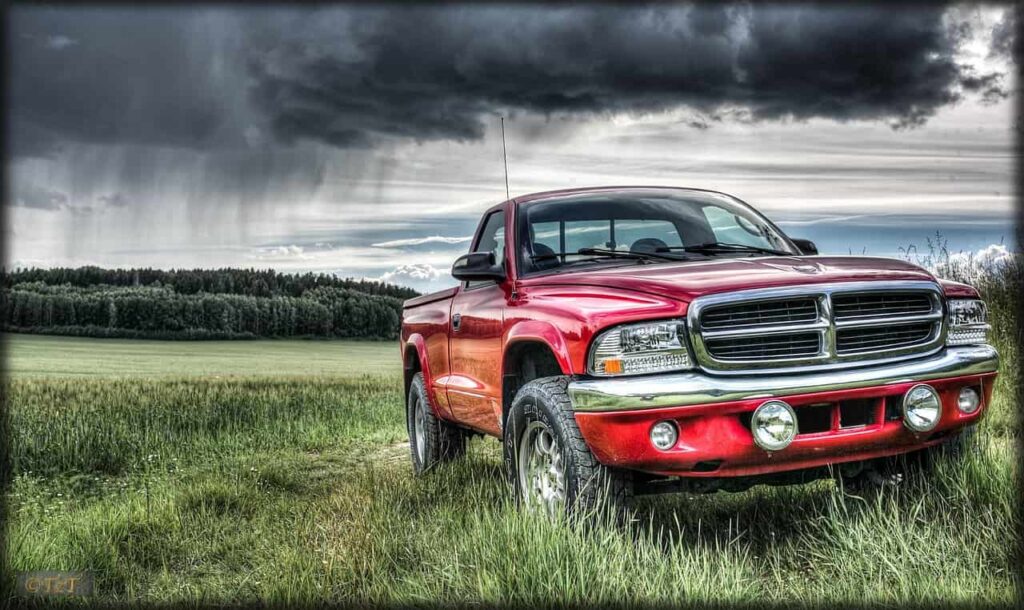The Dodge Dakota is a popular midsize truck that many people still look for when buying used. Like any vehicle, some years are more reliable than others.
The Dodge Dakota years to avoid include 1999, 2000, 2002, 2004, 2005, 2006, 2007–2008, and 2010–2011 due to engine, transmission, and reliability problems, making them less dependable for long-term ownership.
In this article, you’ll discover which Dodge Dakota years to avoid, plus safe picks to help you buy confidently and smartly.
Top 5 Worst Dodge Dakota Years You Should Avoid
Some Dodge Dakota years faced serious problems with engines, brakes, transmissions, and even safety features. Experts and owners agree that the following five years are the most troublesome.
1999 Dodge Dakota
The 1999 Dakota might look solid on the outside, but it’s one of the least reliable models you can buy. Owners reported broken ball joints, unsafe steering, and suspension parts that wore out too quickly.
On top of that, the engine was prone to stalling, overheating, and leaking, often leaving drivers stranded. Brake failures were another big issue, with pedals sticking or fluid leaks cutting stopping power.
Transmission problems like slipping and hard shifting made things worse. With nearly 700 complaints and multiple recalls, the 1999 Dakota is more frustrating than valuable, making it a year every used truck buyer should avoid.
2000 Dodge Dakota
The 2000 Dakota carried over many of the same problems from 1999, and in some ways, they got worse. The brakes were a significant safety concern, with corroded lines causing dangerous leaks and sudden loss of stopping power.
Steering issues remained, thanks to weak ball joints and worn wheel bearings, which sometimes made the truck difficult to control. Lighting problems led to federal recalls, while cosmetic troubles like peeling paint and rust annoyed many owners.
This year, with over 800 complaints and a dozen recalls, became one of Dakota’s worst. Repair bills often stack up quickly, meaning buyers today should avoid the 2000 model unless they want constant trips to the mechanic.
2002 Dodge Dakota

The 2002 Dakota is one of the most infamous years to avoid because of its unsafe design flaws. Drivers experienced severe steering issues, sometimes even losing control of the wheel altogether.
Transmission failures added another layer of danger, with trucks slipping out of Park or shifting on their own. Brakes were also unreliable, leading to scary situations on the road.
Many owners reported their trucks suddenly rolling backward or refusing to stay in gear, causing accidents and property damage. Combined with electrical issues and frequent recalls, this Dakota became a money pit for countless drivers. If you’re hunting for a dependable used pickup, steering clear of the 2002 model is one of the smartest moves you can make.
2005 Dodge Dakota
The redesigned 2005 Dakota kicked off the third generation, but unfortunately, it came with new problems. The most alarming issue was the airbags, which often failed to deploy in accidents or even exploded dangerously.
Several recalls tried to fix these defects, but owners still lost confidence in the truck’s safety. Transmission failures were common, too, with drivers complaining about rough shifting, random gear changes, or the car getting stuck in four-wheel drive.
Electrical problems added to the frustration, and even heated seats posed a fire risk. Safety concerns led to the complaints, and the 2005 Dakota ended up on the list of the worst years to buy. It’s a truck that can’t be trusted for safe, long-term use.
2006 Dodge Dakota
The 2006 Dakota improved slightly from 2005 but suffered significant issues that made it unreliable. Steering problems were the biggest complaint, with many drivers reporting stiff or loose steering, power steering fluid leaks, and even complete failures that made driving unsafe.
Electrical problems were also widespread, from malfunctioning wipers and power locks to dashboard warning lights that wouldn’t turn off.
Airbag defects have been carried over since 2005, putting passengers at risk during crashes. While it wasn’t the worst Dakota ever made, the 2006 model still raises high repair costs and safety concerns. For used truck buyers today, it’s better to skip this year and look for later Dakotas with proven reliability.
8 Common Problems With the Dodge Dakota
- Ball Joint Failures – The Dakota’s front suspension was known for weak ball joints that wore out quickly. This often caused uneven tire wear, clunky noises while driving, and in some cases, unsafe handling that could put drivers at risk.
- Transmission Issues – Many owners reported slipping gears, rough shifting, or the transmission giving out completely. Repairing or replacing the transmission on a Dakota was frustrating and expensive, making this a big concern.
- Brake Troubles – Frequent brake line failures, fluid leaks, and premature rotor wear meant the truck sometimes struggled with reliable stopping power. For a pickup, weak brakes made towing or hauling even more dangerous.
- Engine Stalling – Some Dakotas developed random stalling, overheating, or oil leaks. These issues were inconvenient and could leave drivers stranded, adding stress and repair bills that piled up fast.
- Steering Problems – Power steering fluid leaks, loose steering feel, and poor alignment were common. Over time, this made the truck harder to control and less safe, especially at highway speeds or during heavy use.
- Airbag Defects – Certain model years faced serious airbag recalls. Either the airbags didn’t deploy in accidents or, worse, they deployed unexpectedly, putting both the driver and passengers in danger.
- Rust and Paint Peeling – Body corrosion and peeling paint hurt the truck’s long-term durability and appearance. Many owners complained about rust forming around the wheel wells and frame much earlier than expected.
- Electrical Failures – Faulty wiring and weak electronics led to problems with power locks, dashboard lights, and windshield wipers. While these sound minor, they often turned into constant headaches for owners.
Which Years are Safe to Buy Used?

If you’re shopping for a used Dodge Dakota, the safest model years to consider are generally from 2008 to 2011. By this time, many of the earlier design flaws and reliability problems had been improved.
These later Dakotas came with stronger engines, better safety features, and fewer widespread complaints than older models. Still, looking for a truck with good maintenance records and lower mileage is essential if possible.
Always inspect for rust, suspension wear, and transmission health before buying. A well-cared-for Dakota from these years can be a dependable work truck or daily driver without the constant repair worries tied to earlier models.
What About The Best Year Dodge Dakota
The 2011 Dodge Dakota is widely considered the best year to buy. As the final production year of the Dakota, it benefited from updated engineering, improved towing capability, and a more refined design compared to older models. Many owners praise it for having fewer major reliability complaints, making it a safe choice if you want power without the hassle of constant repairs. It also offered solid V6 and V8 engine options, giving buyers flexibility for work or everyday use. While it may cost a little more than older trucks, the 2011 Dakota gives you the most confidence and peace of mind. Think of it as the “last and best version” of Dodge’s midsize pickup.
2021 Dodge Dakota Years to Avoid
The 2021 Dodge Dakota was never officially released. Dodge had ended Dakota production in 2011, so if you see a “2021 Dakota” online, it’s either a rumor, concept talk, or a mislabeled used truck.
If you want a midsize pickup similar to what the Dakota once offered, you’d need to look at alternatives like the RAM 1500 Classic, Jeep Gladiator, or Chevy Colorado. So, technically, there are no 2021 Dakota years to avoid.
Most Reliable Dodge Dakota Years
The most reliable Dodge Dakota years are usually 2008 to 2011. These trucks had fewer complaints about engines and transmissions than older models and offered stronger build quality.
The 2011 Dakota is the last and best year, often praised for durability and towing power. If appropriately maintained with regular oil changes, these Dakotas can easily cross 200,000 miles, making them a safe choice if you want a dependable midsize pickup without constant repair headaches.
Why Are Dodge Dakotas So Cheap
Dodge Dakotas are often cheaper than other midsize pickups because they’re older, discontinued, and less in demand today. Many buyers prefer newer options like the Tacoma or Colorado, leaving Dakotas overlooked.
On top of that, certain Dakota years had reliability issues, lowering resale value. However, if you find a well-maintained model from later years, it can be a budget-friendly option. The low price isn’t always bad; it just means you must choose carefully.
Dodge Dakota V8 Magnum

The Dodge Dakota V8 Magnum engine was a big selling point for performance fans. Found in earlier Dakotas, this engine offered strong horsepower and torque, making the truck great for towing and hauling.
Many drivers loved its raw, old-school power. However, while the Magnum was tough, it wasn’t the most fuel-efficient. Regular maintenance, like oil changes and cooling system checks, was key to keeping it reliable. For buyers wanting muscle in a midsize truck, the V8 Magnum stood out.
Best Dodge Dakota Engine
The best Dodge Dakota engine is often considered the 4.7L V8 in later models. When properly cared for, it offered a strong balance of power, towing ability, and reliability.
Compared to the older Magnum engines, it was smoother and more modern, giving drivers better performance without being overly thirsty for fuel. Some owners also like the 3.7L V6 for lighter use, but if you want the best mix of strength and dependability, the 4.7L V8 is the winner.
FAQs
1. What color antifreeze does a Dodge Dakota take?
Most Dodge Dakotas use HOAT coolant, which is orange or pink. Always check your owner’s manual to stay safe and avoid mixing with the wrong antifreeze.
2. What kind of antifreeze does a 2006 Dodge Dakota take?
The 2006 Dodge Dakota requires HOAT orange/pink coolant. Avoiding green or universal coolants is essential, as using the wrong type may damage your cooling system.
3. What years of Dodge to avoid?
It’s smart to avoid Dodge Dakota years 2000, 2002, 2005, and 2006. These had major engine, transmission, and suspension issues, leading to costly long-term repairs.
4. What is the best year for the Dodge Dakota 4×4?
The 2011 Dodge Dakota 4×4 is the best year. The final generation offers strong reliability, improved power, and fewer problems than earlier models.
5. Does Dodge use special coolant?
Dodge vehicles use HOAT or OAT coolants, not universal green antifreeze. Always match the coolant type in your manual to keep your engine safe.
Conclusion
The Dodge Dakota remains a classic mid-size pickup, but not every year is worth your money. The worst years — 1999, 2000, 2002, 2005, and 2006 — are plagued with problems that can drain your wallet and put you at risk. On the other hand, the later models, especially 2010 and 2011, have proven to be safe, reliable, and trusted by many owners.
When shopping for a used Dakota, always check recalls, service history, and owner reviews. By steering clear of the bad years and aiming for the proven good ones, you’ll enjoy a truck that works hard, keeps you safe, and lasts for years.




